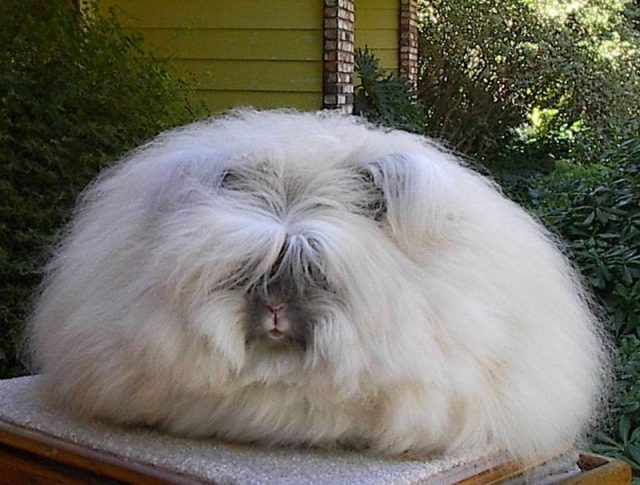Type the name of the breed you're looking for below
[wpdreams_ajaxsearchlite] Don't see the breed your're looking for? Click here and let us know!
Breed Characteristics
1 paw - breed exhibits the least amount of this characteristic
5 paws - breed exhibits most amount of this characteristic
English Angora rabbit
| Origin | An English Angora is to have the appearance of a round ball of fluff — and that’s a quote from the Standard. One of these rabbits in show coat is a remarkable creature that can look more like a Pekinese dog than a rabbit. There are six breeds of rabbits with wool recognized by the ARBA, but this one has the most wool on the ears, feet, and legs in addition to the body. It is also the smallest Angora breed, but at 5-7 pounds is larger than the Fuzzy Lop or Jersey Wooly. A prime English Angora is tough to beat on the Best in Show table, as evidenced by the number of times it has won this honor at ARBA National Conventions. But getting a rabbit into prime coat is no easy task. Due to its soft texture, the English Angora coat demands even more grooming than that of other Angora breeds. Grooming begins when a kit is eight weeks old, starting with a wide-toothed comb. As the rabbit matures, a slicker brush should be used. Recommended grooming procedures vary based on the stages of coat development, but all Angoras in coat should be groomed once or twice per week. Modern breeders find that the most useful tool on an adult coat is a professional-grade blower, like the kind used on sheep or dogs. A blower will help separate the hairs and prevent felting or webbing, giving the coat that “falls free” property that the standard calls for. When the coat starts to slip, it is usually trimmed or plucked. Enzyme tablets are often given to prevent the fatal condition of wool block. Wool is the most important features when judging the English Angora. Wool texture should be soft and silky. Guard hairs should be present, but not as prevalent as in the French Angora. Wool length must be at least two inches, but the standard says that no bonus points should be awarded to rabbits with wool longer than five inches. None the less, top English Angoras these days have wool that is up to 12 inches long! Density is of high importance. The Standard disqualifies a complete lack of wool on the head or normal fur about the ankle on the front leg. The body type is round and compact. The head should be flat-faced. This breed is recognized in many varieties, but shown in two groups: white and coloured. Breeders are working hard to get brokens accepted. |
Physical Attributes
| Weight | 5 - 7 lbs. (2.3 - 3.2 kg) |
| Ear Type | Erect |
| Fur Type | Wooly |
| Colours | Many. Shown in white and coloured classes. |
| Appearance | Thick wool covers the entire rabbit, including the face and the stand-up ears, giving in the appearance of a large fuzz-ball. |
| Other Considerations | Life Expectancy: 5 - 8 years Temperament: Docile |
| Best Kept In | Pen, Cage |



